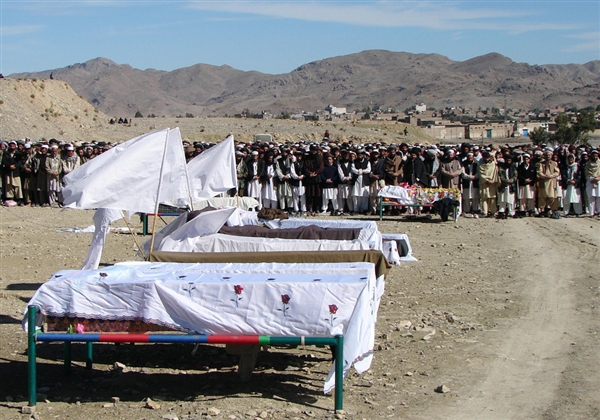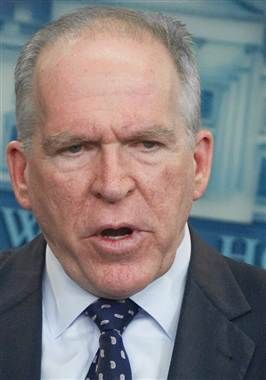
In doing so, he became the first U.S. government official to acknowledge that the drone strikes sometimes kill innocent people, though he characterized such deaths as "exceedingly rare." But a new analysis by an independent Washington think tank estimates that more than 300 civilians have been killed by drones since President Barack Obama took office.
In a major speech on the anniversary of Osama bin Laden's death during a raid in Abbottabad, Pakistan, by U.S. Navy SEALs, Brennan proclaimed that al-Qaida is now "on the path to its destruction." But the headline was what he had to say about the drone program - long a forbidden subject for senior U.S. officials - and how the U.S. government uses it.
"The United States conducts targeted strikes against specific al-Qaida terrorists, sometimes using remotely piloted aircraft, often referred to publicly as drones," said Brennan, in his speech at the Woodrow Wilson International Center for Scholars, a Washington, D.C., foreign policy think tank.
While it has been openly reported in the press for years, the use by the CIA of pilotless drones to kill members of al-Qaida has long been officially classified, prompting government officials to talk obliquely about "lethal operations" and "removal" of terrorists. They have done so even as Obama has dramatically escalated the number of such attacks and made them the central component of the administration's counterterrorism efforts.

Under Obama, there have been an estimated 250 drone strikes in northwest Pakistan that have killed as many as 2,345 people, according to an analysis by the New America Foundation, a Washington think tank that closely tracks the program. Such strikes have generated a storm of protest in Pakistan and stepped up demands by the Pakistani government to halt them.
In what he described as an effort to be more open with the American people, Brennan on Monday described an elaborate process under which senior government officials select targets for drone strikes. They must first determine whether a prospective target is a bona fide member of al-Qaida or "associated forces" and poses a "significant threat" to U.S. interests. The "lethal action" strikes are not used for "punishing terrorists for past crimes" or "seeking vengeance." Instead, they are used to "stop plots" and "prevent future attacks," citing as one example, targeting individuals who possess "unique operational skills."
Brennan said the use of drones gives U.S. intelligence agencies the ability to use "laser-like" precision against the terrorists. But he acknowledged that "innocent civilians have been killed in these strikes." He said such instances have been "exceedingly rare, but it has happened.
"When it does, it pains us and we regret it deeply, as we do any time innocents are killed in war," he added.
That passage of his speech alone was significant. In June 2011, Brennan said that in the previous year of operations in the government's then-unspecified program to eliminate al-Qaida members, "There hasn't been a single collateral death because of the exceptional proficiency, precision of the capabilities we've been able to develop."
Brennan later changed that statement in response to questions by the New York Times, spurred in part by reports about a May 6 strike in Pakistan that hit a religious school, an adjourning restaurant and a house, killing 18 people. Although 12 militants were allegedly killed, British and Pakistani journalists on the scene reported that six civilians also died in the strike.
In Brennan's adjusted statement last year, he said, "Fortunately, for more than a year, due to our discretion and precision, the U.S. government has not found credible evidence of collateral deaths resulting from U.S. counterterrorism operations outside of Afghanistan or Iraq."
Brennan did not give any details on Monday about how rare civilian deaths have been. But according to the analysis by the New America Foundation, which relies heavily on local media and other reports from observers in Pakistan, about 17 percent of those who have been killed by drones since the program effectively began in 2004 were "non-militants." The foundation estimated that the "non-military fatality rate" has since dropped to about 13 percent under Obama - as drone strikes have become more frequent and more precise.
Those numbers translate to 471 civilian deaths, including 309 under Obama.
Human rights groups - who have challenged the administration to be more open about its drone program - were not satisfied with the new details provided by Brennan's speech.
"It is not enough that care is taken to avoid harm to innocent civilians," said Raha Wala, an official with Human Rights First. "Brennan's assertion that any 'member' of al-Qaida or 'associated forces' is legally targetable is wrong. Under the laws of armed conflict, only members of the enemy's armed forces, or those directly participating in hostilities or who perform a continuous combat function, may be targeted."



Comment: We won't go into Navy Seals and Osama. Osama bin Laden corpse photo is fake
Instead we'll travel down memory lane about these Drones that somehow miss civilians:
Drone kills 25 on eve of mass protest, US drone strike kills 25 in Pakistan, US drone kills 8 in Pakistan, drone strikes have killed over 130 in Yemen, US Drone Strike Kills 78 in Somalia, US drone strike kills 23 in Pakistan It's easy to get to over 250 men, women and children. Perhaps Brennan ran out of fingers or forgot a digit? And this small group of articles isn't the whole, and if you think about it, what about the forgotten and hushed numbers that didn't make it into the main stream media?